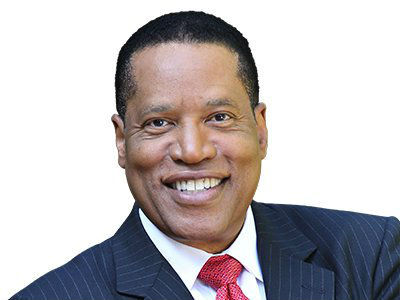7 Signs We Are in the End Times
Spiritual Life

Audio By Carbonatix
4:00 AM on Tuesday, October 21
By Britt Mooney, Spiritual Life

1. Natural Disasters
In Matthew 24:7-8, Jesus speaks of earthquakes, famines, and pestilences as signs preceding His return. Throughout history, natural disasters have been interpreted by many Christians as indicators of the nearing end times, signaling God’s judgment and the fulfillment of biblical prophecy.
In recent times, the frequency and intensity of natural disasters have led some to perceive them as confirmation of biblical end-time prophecies. For example, the increasing occurrence of devastating hurricanes, wildfires, earthquakes, and tsunamis in various parts of the world has prompted discussions about their significance in relation to biblical eschatology.
Hurricane Katrina, which struck the United States in 2005, causing widespread destruction and loss of life, was viewed by some as a sign of God’s judgment, although that is difficult to know for sure. Similarly, the 2011 earthquake and tsunami in Japan, which resulted in thousands of deaths and widespread devastation, raised questions about the role of natural disasters in biblical prophecy. In 2024, several significant earthquakes have occurred globally, sparking discussions among some groups who believe these events are signs of the end times. Notable earthquakes this year include a 7.5 magnitude quake in Japan which caused significant damage and loss of life, and a 7.4 magnitude quake offshore of Hualien, Taiwan.
Furthermore, the ongoing climate crisis and its associated impacts, such as rising sea levels and extreme weather events, have heightened concerns about the relevance of biblical end-time prophecies. Many Christians interpret these environmental crises as signs of the earth “groaning” in anticipation of the return of Christ, as described in Romans 8:22.
As natural disasters continue to occur with increasing frequency and severity, discussions about their significance in relation to biblical prophecy are likely to persist.
Photo Credit: ©Getty Images/ Roman Novitskii

2. War and Conflicts
Jesus speaks of “wars and rumors of wars” in Matthew 24:6-7 as indicators of the nearing end. Throughout history, these violent and tumultuous times have been viewed by many Christians as connected to biblical prophecies. Signaling a period of tribulation and unrest preceding the return of Christ.
In modern times, the prevalence of wars and conflicts around the world has heightened concerns about their significance in relation to biblical end-time prophecies. Within the past century, the world has seen two world wars, and World War II was an actual planet-wide conflict with frightening weapons like nuclear arms.
Examples of recent conflicts, such as the ongoing civil war in Syria, the conflict between Israel and Palestine, and the rise of terrorist groups like ISIS, have fueled discussions about their role in fulfilling biblical prophecy. The current Israeli-Palestinian conflict, characterized by decades of violence and political strife, has been viewed by many as a fulfillment of biblical prophecies regarding the restoration of Israel and the Middle East conflict preceding the return of Christ.
Furthermore, the rise of terrorism and extremist ideologies, exemplified by groups like ISIS, Al-Qaeda, and Boko Haram, has led to widespread fear and uncertainty, prompting discussions about their role in biblical end-time scenarios.
Related Podcast: Breaking Down the Hostage Deal Between Israel and Hamas
Hosts Joel and Lynn Rosenberg tackle the emotionally charged and complex issue of Israel's latest hostage deal with Hamas. With Joel asserting that Israel is faced with negotiating with a "satanic organization," the episode delves into the harrowing details of the 467-day ordeal since October 7, 2023. Want an informed, Biblical perspective on the Middle East? Subscribe to Inside the Epicenter on Apple or Spotify so you never miss an episode!
Photo Credit: ©Getty Images/Christopher Furlong / Staff

3. Famine and Disease
In Matthew 24:7, Jesus speaks of “famines and pestilences” as indicators of the coming end. Throughout the previous centuries, famine and disease outbreaks have been discussed by many Christians as the fulfillment of biblical prophecy.
In modern times, the prevalence of famine and disease outbreaks around the world has heightened concerns about their significance in relation to biblical end-time prophecies. Examples of recent famines, such as the food crises in Yemen, South Sudan, and parts of Africa, have led to widespread starvation and humanitarian emergencies, prompting discussions about their role in fulfilling biblical prophecy.
The world has seen a number of recent serious disease outbreaks. From the HIV/AIDS virus in the 80s, SARS in 2002, H1N1 in 2009, and Ebola in 2014-2016, millions have died from these far-reaching diseases.
The ongoing COVID-19 pandemic, caused by the novel coronavirus, has also been viewed by many as a sign of the end times. The pandemic has resulted in millions of deaths worldwide, overwhelmed healthcare systems, and disrupted economies and societies on a global scale. The rapid spread of the virus and its devastating impact have led some to interpret it as a fulfillment of biblical prophecies regarding pestilences and plagues preceding the return of Christ.
Moreover, the emergence of new infectious diseases, antibiotic-resistant pathogens, and other public health threats has raised concerns about the potential for future pandemics and their role in biblical end-time scenarios.
Photo Credit: ©Getty Images/fizkes

4. Moral Decay
The apostle Paul, in 2 Timothy 3:1-5, mentions moral decay as a sign of the coming end, where people will be “lovers of themselves, lovers of money, boastful, proud, abusive, disobedient to their parents, ungrateful, unholy, without love, unforgiving, slanderous, without self-control, brutal, not lovers of the good, treacherous, rash, conceited, lovers of pleasure rather than lovers of God.”
Christians throughout history have paid attention to periods of moral decline and spiritual apostasy as potential signs preceding the return of Christ.
Today, examples of moral decay can be observed in various aspects of society, including the breakdown of traditional family structures, including high divorce rates, single-parent households, and declining marriage rates, reflecting a departure from biblical principles of marriage and family. Our culture has also experienced increasingly permissive attitudes towards sexuality, pornography, substance abuse, and other forms of immorality indicating a shift away from biblical morality and values.
The growing influence of secularism and relativism has led to a rejection of absolute truth and moral absolutes, resulting in moral relativism and the acceptance of diverse lifestyles and beliefs. Disrespect for authority, erosion of trust in institutions, and increasing polarization and division within society contribute to moral decay and societal unrest.
As moral decay continues to manifest in various aspects of society, discussions about its role in eschatological narratives are likely to persist.
Photo Credit: ©©Getty Images/Gearstd

5. False Prophets
Back in Matthew 24, Jesus warns of false prophets who will arise during the last days and deceive many. Throughout Scripture, false prophets are depicted as individuals who claim to speak on behalf of God but propagate deceitful teachings and lead people astray from the truth.
In modern times, false prophets continue to exist, disseminating misleading teachings and exploiting people’s spiritual vulnerabilities for personal gain. Examples of false prophets and deceptive religious movements can be observed in various contexts.
Some self-proclaimed Christian leaders promote a distorted version of the gospel that emphasizes material wealth and financial prosperity as signs of God’s favor. They often manipulate scripture to promote the idea that faithfulness to God leads to material success, exploiting vulnerable believers and perpetuating a message contrary to biblical teachings on humility, sacrifice, and stewardship.
Numerous cults and fringe religious movements have emerged throughout history, led by charismatic leaders who claim divine authority and offer exclusive access to spiritual truth. These groups often use manipulation, coercion, and isolation to control their followers and maintain power, leading to psychological and emotional harm. These have increased in the past century.
Various new age and spiritualist movements promote syncretic beliefs and practices that blend elements of different religious traditions with esoteric teachings and mystical experiences. While some may offer insights into spirituality and personal growth, others promote deceptive ideologies and false claims of spiritual enlightenment.
Photo Credit: ©Juan Pablo Rodriguez/Unsplash

6. Persecution of Believers
Jesus cautions in Matthew 24:9-10 that during the last days, believers will be persecuted and hated because of their faith. Throughout the Bible, persecution is depicted as a hallmark of discipleship and a fulfillment of Jesus’ words that “in this world you will have trouble” (John 16:33).
Persecution of Christians continues to occur around the world. In fact, there have been more martyrs to Christianity in the past century than in the previous 1800 years combined. Examples of persecution of Christians include the following
In countries where religious extremism holds sway, such as parts of the Middle East, Africa, and Asia, Christians are often targeted for their faith. They face violence, discrimination, and oppression at the hands of extremist groups who seek to eradicate Christianity from their territories. In some countries with authoritarian regimes, Christians are persecuted by the state for their religious beliefs. They may face imprisonment, torture, or even death for practicing their faith or engaging in evangelism.
In areas of conflict or civil unrest, Christians are often targeted by armed groups or factions seeking to advance their political or ideological agendas. They may be subjected to attacks, bombings, or forced displacement, resulting in loss of life, property, and livelihoods. In societies where Christianity is viewed as a threat to cultural or national identity, Christians may face social discrimination, harassment, or exclusion from certain sectors of society. They may be denied access to education, employment opportunities, or public services because of their faith.
Photo Credit: © Unsplash/Tiago Bandeira
7. False Christs
Finally, as the return of the Messiah nears, the Devil will bring more counterfeit versions. In Matthew 24:24, Jesus cautions that during the end times, many false messiahs will arise and deceive crowds of followers. False christs are individuals who claim to be the Messiah or Savior but propagate deceitful teachings and lead people away from the true faith.
False christs continue to emerge and seem to be occurring more in the past century.
Jim Jones founded the Peoples Temple and styled himself as a messianic figure, claiming to be the reincarnation of Jesus, Buddha, and Lenin. He led his followers to establish Jonestown, where over 900 members died in a mass murder-suicide in 1978.
Leader of the Branch Davidians, David Koresh, claimed to be the final prophet and the “Lamb of God” mentioned in the Book of Revelation. He and many of his followers died in a standoff with law enforcement in Waco, Texas, in 1993.
Sun Myung Moon founded the Unification Church, also known as the Moonies. Moon claimed to be the second coming of Christ and taught his followers to view him as the messiah. He gained a large following and built a religious empire.
Co-founder of the Heaven's Gate cult, Marshall Applewhite, preached that he and his followers were extraterrestrial beings sent to Earth to guide humanity to the “next level” of existence. He claimed to be the “present representative” of Jesus Christ and led his followers in a mass suicide in 1997, believing they would be transported to a spaceship trailing the Hale-Bopp comet.
Two important things to remember when you're curious about distinguishing signs of the end times. First, these are modern examples of the signs Jesus and the apostles spoke about. However, to some degree, these signs appear in every generation. They reveal the sin and corruption of humanity and the systems of this world, making the verses in Matthew 24 and Revelation relevant to every generation.
Second, while some signs are more intense today than ever before (world wars as an example), our modern communication and media might give us the perception things happen more than in generations past. We must be careful to both watch for the signs as Jesus said but also to be careful not to jump to conclusions.
Regarding the end times, the core teaching by Jesus and the writers of the New Testament points us to constant readiness. Even when we recognize the signs in the modern day, the end will come as a surprise. We must keep our lamps full of oil and lights lit, waiting for the coming of Jesus and the coming redemption of all things.
Read more:
What and When is the Battle of Armageddon?
What Does the Bible Really Say About The Rapture?
Who Are the Four Horsemen of the Apocalypse?
Photo Credit: ©GettyImages/wildpixel


























